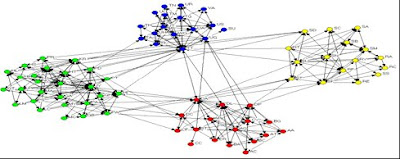Social Network Analysis: The Power of Informal Networks
I attended the “Network Roundtable” conference here in Virginia.
Social Network Analysis (“SNA”), also known as Organizational Analysis “ONA” is an established field with many professionals who make their living doing this (who knew?) It was not a large conference but people came from across the country and around the globe to attend. This was an introduction to the concepts for me but I found it very interesting, as sort of the “real-world basis” for online Social Media. It provides the foundation and background I have been seeking for why Social Media is so compelling…because it’s based in basic human interactions.
Rob Cross is a professor of management at UVA. He is an excellent presenter with a great sense of humor and great energy. Everyone laughed when he described how the more scientific approach to Organizational Network Analysis can (and should) replace the “kumbaya off-sites with executives falling into each other’s arms.”
The conference offered a very academic approach. The goal is to diagnose issues within an organization, and the tactics are through surveys and interviews. What you usually see is a diagram that looks like a constellation, identifying the connections and relationships between individuals. You can see which individuals are highly connected or integrated, as well as those that are on the periphery.
SNA can be useful for onboarding new employees, as well as helping existing employees with their transitions. It can be used to identify “bottlenecks” such as an executive who does not have the time to approve all the requests that come their way. It helps with Operational efficiency. For me, the most compelling use of it is to find out who in your organization is most connected, and is adding value by acting as a “bridge” between disparate groups. Once these valuable people are identified, they can be rewarded / motivated to stay with the company. It is fairly scientific in that it is based on data gathering and I saw a lot of these types of “constellation” charts.
There were a lot of case studies presented, including Microsoft, 3M, IBM and Raytheon. But I’m still somehow at a loss for how this methodology might be applied to my own company. Maybe that is because I’m still new to the concepts, and I have no background in Organizational Development or HR. One strong message that was communicated is “forget about the tools.” That’s funny because I ended up at the conference because I was brought into an evaluation of Internal Collaboration Software because of my expertise in Social Media. I became involved in the issue of building internal community.
One favorite presentation was Larry Prusak, who drew upon historical and economic principles to make his point about the importance of knowledge and networks. He insists that online social networks can never replace those in the “real world.” I think that the next generation of Internet users will prove him wrong!
Personally I really appreciated Ted Smith, a marketing guy who pointed out that marketing and PR pros tend to focus only on those individuals who are “Most connected” (e.g., the uber bloggers / influencers) while in fact, there are more individuals who are PRETTY well connected, and they appreciate the same messages as the “ultra connected” folks. I asked him to send me some more concrete examples.
I also really enjoyed the presentation by Margaret Schweer, who referenced a lot of the Web 2.0 technologies, and explained what ONA is REALLY good for. She provided a good summary of how HR might be able to use these techniques.
On the first day of the conference, Peter Gloor left everyone buzzing when he showed us how analysis of online info (blogs and online forums) can predict the real world interactions, including stock prices!
Grady Bryant has given me a copy of Rob Cross’ book: “The Hidden Power of Social Networks: Understanding how Work Really Gets Done in Organizations” so now I’ll be able to brush up on some of the ideas that are new to me.

2 Comments
Gia · September 27, 2008 at 7:05 pm
Oh cool! you got to hear Rob Cross in person? You should check out his case studies for deets about how S/ONA can help companies “socially engineer” their organizations to achieve specific stuff. A great example of ONA at work is an arcticle called The Craft of Connections (no relation to any software). Just google that title, and you should find it.
I’m so envious. 🙂
theschweerline · October 8, 2008 at 4:02 pm
Karen, what a pleasure to meet a fellow blogger at the Network Roundtable. I am delighted you found the material useful — I in turn have enjoyed reading your examples!
Comments are closed.